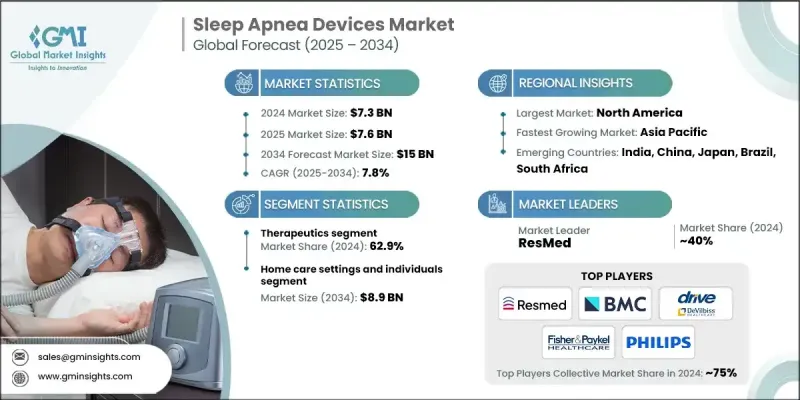
|
市場調査レポート
商品コード
1833638
睡眠時無呼吸装置の市場機会、成長促進要因、産業動向分析、2025年~2034年予測Sleep Apnea Devices Market Opportunity, Growth Drivers, Industry Trend Analysis, and Forecast 2025 - 2034 |
||||||
カスタマイズ可能
|
|||||||
| 睡眠時無呼吸装置の市場機会、成長促進要因、産業動向分析、2025年~2034年予測 |
|
出版日: 2025年09月15日
発行: Global Market Insights Inc.
ページ情報: 英文 140 Pages
納期: 2~3営業日
|
概要
睡眠時無呼吸装置の世界市場規模は、2024年に73億米ドルとなり、CAGR7.8%で成長し、2034年までには150億米ドルに達すると予測されています。

この成長を牽引しているのは、世界的な睡眠時無呼吸症候群の患者数の増加、睡眠障害に対する意識の高まり、高度でポータブルな治療ソリューションに対する需要の高まりです。睡眠時無呼吸装置は、睡眠呼吸障害の診断と管理の両方に使用され、気道を開いた状態に保ち、患者の睡眠状態を効果的にモニターするのに役立っています。しつこいいびき、日中の疲労感、集中力の低下などの症状を自覚する人が増えるにつれ、受診や睡眠障害の診断が一般的になってきています。検査室ベースの睡眠ポリグラフ検査や家庭用検査キットなど、睡眠検査方法の革新が、この診断率の急上昇にさらに貢献しています。より多くの患者が正式に診断されるにつれて、CPAP、BiPAP、その他の睡眠時無呼吸治療技術のような装置の需要は増加の一途をたどっています。これらのデバイスは、未治療の睡眠時無呼吸症候群の健康リスクを低減し、患者ケアの改善と全体的な生活の質の向上に役立っています。
| 市場範囲 | |
|---|---|
| 開始年 | 2024年 |
| 予測年 | 2025年~2034年 |
| 市場金額 | 73億米ドル |
| 予測金額 | 150億米ドル |
| CAGR | 7.8% |
2024年、診断分野が37.1%のシェアを占めました。この成長は、睡眠障害の早期発見への注目の高まりと、コンパクトでAIを搭載した診断ツールへのアクセスの拡大から生じています。これらの技術がより洗練され、手頃な価格になるにつれて、睡眠時無呼吸症候群のスクリーニングは、患者と医療提供者の双方にとってより迅速かつ便利になりつつあります。在宅検査とリアルタイムのデータ分析の進化は、診断能力と市場の拡大を強化し続けています。
在宅医療および個人セグメントは、2024年に56.9%のシェアを占め、臨床環境以外での費用対効果の高い長期的治療ソリューションに対する需要の高まりに後押しされ、2034年までに89億米ドルを創出する見込みです。睡眠時無呼吸症候群を自宅で管理することで、頻繁な通院や入院費用を削減することができます。在宅治療への保険適用が拡大し、予算に見合った治療オプションが利用できるようになったことで、在宅睡眠療法が幅広い人々にとってより身近なものとなり、より多くの人々が自分の状態を自立して手頃な価格で管理できるようになっています。
北米の睡眠時無呼吸装置市場は2024年に37.6%のシェアを占め、強固なヘルスケアインフラ、確立された償還エコシステム、睡眠関連の健康問題に対する人々の高い意識に支えられています。同地域では、睡眠時無呼吸症候群の治療・診断技術の早期導入が引き続き好調です。遠隔モニタリング・プラットフォームとコネクテッド・ヘルス・ソリューションの統合は、この地域の患者ケアをさらに前進させています。Drive DeVilbiss、BMC、ResMed、Teleflex、Fisher &Paykel、Philipsなどの主要な業界企業は、CPAP、BiPAP、遠隔睡眠検査ソリューションを含む包括的なポートフォリオを提供することで、北米での地位を固めています。
睡眠時無呼吸装置の世界市場で活躍する主要企業には、Cadwell、DynaFlex、Asahi KASEI、Glidewell、Apnea Sciences、SomnoMed、NIHON KOHDEN、Natus、WEINMANNなどがあります。世界の睡眠時無呼吸装置市場における地位を強化するため、企業はいくつかの中核戦略を展開しています。これらには、機器の精度、携帯性、患者の快適性を高めるための研究開発への一貫した投資が含まれます。企業は、リアルタイムのデータモニタリングや遠隔医療との互換性をサポートするコネクテッド技術を導入しています。さらに、睡眠クリニック、在宅ケアプロバイダー、保険ネットワークとの提携が流通拡大に役立っています。マーケティングイニシアチブは、一般市民の認識を高め、早期診断を奨励することに重点を置いています。さらに、各社は規制当局の承認を通じて新市場に参入し、特に在宅医療における世界的な需要の高まりに対応するため、スケーラブルな生産体制を構築しています。
目次
第1章 調査手法と範囲
第2章 エグゼクティブサマリー
第3章 業界考察
- 業界エコシステム分析
- 業界への影響要因
- 成長促進要因
- 睡眠時無呼吸症・関連合併症の発生率の増加
- ポータブルで高性能な睡眠時無呼吸ソリューションの需要増加
- 睡眠時無呼吸症と睡眠障害に対する意識の高まり
- 高齢化が進むにつれ需要が増大
- 技術的進歩
- 業界の潜在的リスク・課題
- 睡眠時無呼吸症候群の治療遵守の欠如
- 製品リコールと安全性に関する懸念
- 市場機会
- 新興市場への進出
- AIとデジタルヘルスの統合
- 成長促進要因
- 成長可能性分析
- 規制情勢
- 技術的情勢
- 現在の技術
- 新興技術
- 将来の市場動向
- 払い戻しシナリオ
- 睡眠時無呼吸症治療機器における睡眠時無呼吸症インプラントの役割の進化
- パイプライン分析
- 投資情勢
- 起動シナリオ
- 価格分析、2024年
- ポーター分析
- PESTEL分析
- ギャップ分析
第4章 競合情勢
- イントロダクション
- 企業マトリックス分析
- 企業の市場シェア分析
- 北米
- 欧州
- アジア太平洋
- ラテンアメリカ、中東・アフリカ
- 主要市場企業の競合分析
- 競合ポジショニングマトリックス
- 主な発展
- 合併と買収
- パートナーシップとコラボレーション
- 新製品の発売
- 拡張計画
第5章 市場推計・予測:製品別、2021年~2034年
- 主要動向
- 治療薬
- 気道クリアランスシステム
- 陽圧呼吸(PAP)装置
- 持続的陽圧呼吸療法(CPAP)装置
- 二相性陽圧呼吸(BiPAP)装置
- 自動陽圧呼吸(APAP)装置
- 適応型サーボ換気(ASV)装置
- 口腔装置
- 下顎前進装置
- 舌保持装置
- 急速な上顎拡大
- マウスガード
- その他の治療法
- 診断
- 睡眠ポリグラフ検査(PSG)装置
- 携帯型PSG装置
- 臨床用PSG装置
- アクティグラフィーシステム
- パルスオキシメーター
- 家庭用睡眠検査(HST)装置
- タイプ2
- タイプ3
- タイプ4
- 呼吸ポリグラフ
- 睡眠ポリグラフ検査(PSG)装置
第6章 市場推計・予測:最終用途別、2021年~2034年
- 主要動向
- 在宅医療・個人
- 睡眠研究室と病院
第7章 市場推計・予測:地域別、2021年~2034年
- 主要動向
- 北米
- 米国
- カナダ
- 欧州
- ドイツ
- 英国
- フランス
- スペイン
- イタリア
- オランダ
- アジア太平洋
- 中国
- 日本
- インド
- オーストラリア
- 韓国
- ラテンアメリカ
- ブラジル
- メキシコ
- アルゼンチン
- 中東・アフリカ
- 南アフリカ
- サウジアラビア
- アラブ首長国連邦
第8章 企業プロファイル
- Asahi KASEI
- BMC
- Cadwell
- Drive DeVilbiss
- FISHER &PAYKEL
- natus
- NIHON KOHDEN
- Philips
- ResMed
- Teleflex
- WEINMANN
- Glidewell
- DynaFlex
- SomnoMed
- Apnea Sciences


